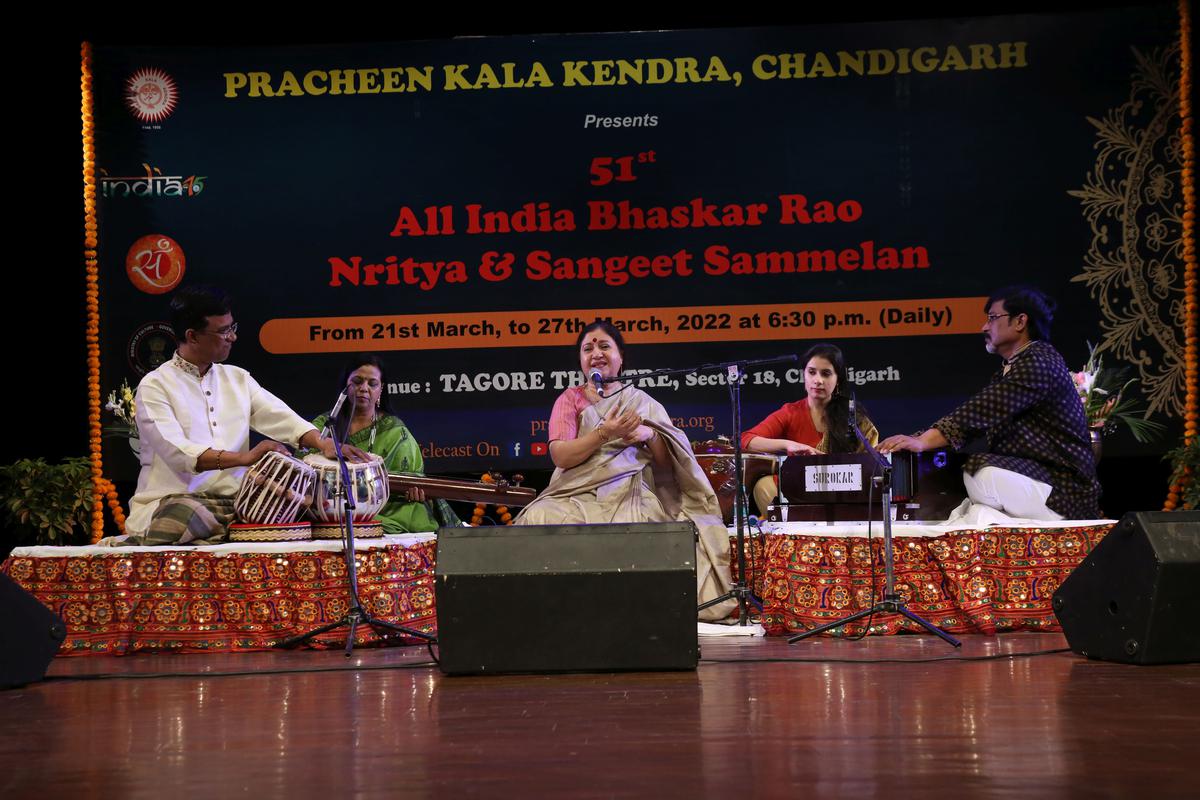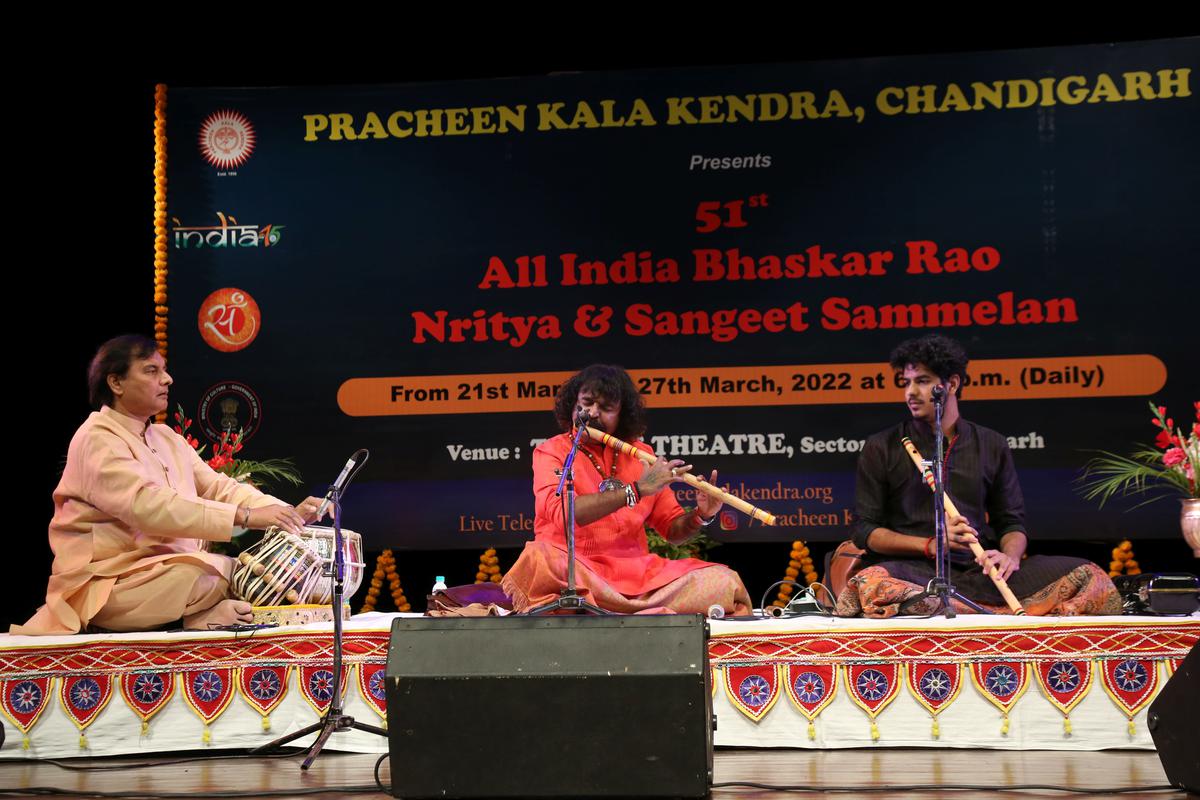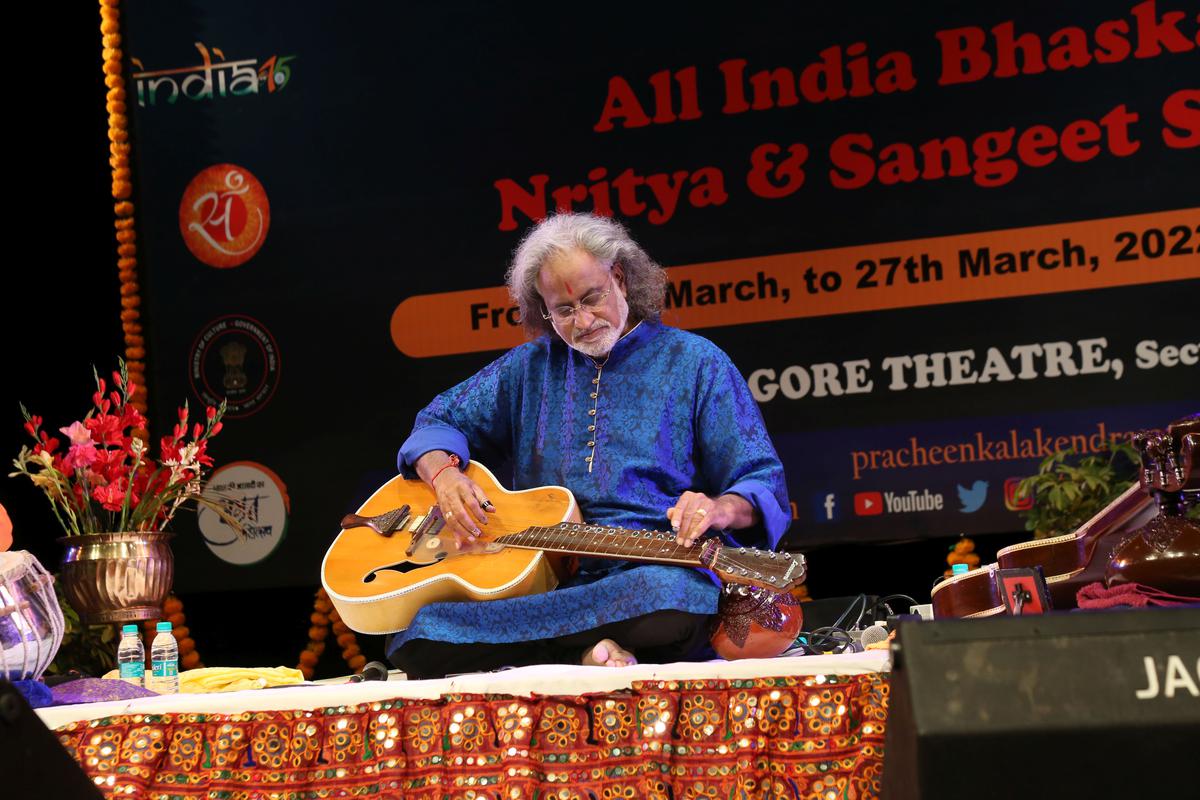51st Bhaskara Rao Dance and Music Conference was a mixture of rhythm and melody
51st Bhaskara Rao Dance and Music Conference was a mixture of rhythm and melody
Sudipto Malik
The 51st edition of the week-long All India Bhaskar Rao Dance and Music Conference of Prachin Kala Kendra was held recently at Tagore Theatre, Chandigarh. Named after Ustad Gyanacharya Bhaskarbua Bhakhle, it featured performances by both young and established artists. Tabla player Suresh Talwalkar and daughter Savani started the program with their performance. He was accompanied by Nagnath Adgaonkar (Vocal), Abhishek Sinkar (Harmonium), Ishaan Paranjpe (Cajon and Parant), and Rituraj Hinge (Kalbash).
Leaving the traditional peshkar, kaida, rela, madhyalay, gat, tukra, padan and chakradhar sequences, the senior artist presented an extended jhap taal – peshkar and Punjabi kaida – and the parasbandi chautal. Through Barik Chautal, he showed how the Tala Chakra should be practiced. “Do-three-four-one is how one should start. Follow it earnestly,” he said. This was followed by Bandish, ‘Chalo Hatto Piya’, in Raag Sohini, set at Adha Aara Chautal. Nagnath presented Suresh Talwalkar’s lively lyrics blended seamlessly with Nagnath’s voice, emphasizing the laconic and vocal aspects conveyed by his mentor. He concluded with a strong chakradhar.
Pro. Harvinder Singh. , photo credit: special arrangement
In the second day Prof. Harvinder Singh had a concert. The musician from Chandigarh chose Raag Bagshree. His employment of Canada-ang (ga-ma-ray-sa) could be brought under scrutiny. His rendition of the bandish ‘Sakhi Mann Lage Na’ in Vilambit Ektal was clearly marked, followed by Drut Teentaal and Tarana. He concluded with Khambaz Thumri. He was accompanied by Mithilesh Jha and Rajendra Prasad Banerjee on Tabla and Harmonium.
Sarodist Pt. Seniya Debashish Bhattacharya of Shahjahanpur Gharana, who performed next, presented a melodious raga of Khamaj Thaat in Vilambit Kishore Taal for Jhinjhoti. He continued with the raga Kalavati in Madhyaalaya Ektaal, and Mishra was positioned with Peelu Dhun. However, an unnecessary over-indulgence with Tanpura, for which he apologized, spoiled the mood. Durjay Bhowmik stood firm on the tabla.
rich heritage

Tulika Ghosh. , photo credit: special arrangement
Tabla player Pt. Nikhil Ghosh, and niece of famous flautist Pannalal Ghosh combined the flavors of Atrauli, Gwalior, Sahaswan, Kirana, Patiala and Banaras Gharana in their singing. His first meeting was Raga Shree. After the aap, he presented the bandish in the jhaptal. In Maharaja Chakradhar Singh’s ragmala, ‘Re Re Bahar Aai Re Chayanatbar’, the tempo changed when he entered ‘Gaure Kul Tilak Manohar’, allowing tabla accompanist Durjay Bhowmik to bring his skills to the fore. The Banarasi hymn, ‘Banwari ki surtiya expansion nahi’ was his last part.
separate household
Sitar player Partha Bose. , photo credit: special arrangement
Sitar player Partha Bose, Manoj Shankar of Pt. Maihar Gharana chose to perform Raga Bihag in three gatas – Khayal-Aang, Tantriki and Longi in madhale for their evening concert. Partha Bose’s attempt to import the Etawah-Imdakhni Aang Jor-Jhala failed due to lack of proper application to embellish his singing. He might have stayed on his known ground. He wound up with a pleasant kaffi thumri with desi todi inflections.
Singer Shaunak Abhisheki of the Agra and Jaipur gharanas also joined on the fourth day. Raga Sarasvati in Rupak tal, and Drut in Adha taal was followed by a Bhinna Shadja thumri, ‘O Purana Chandrabha’.
thematic presentation
Unlike this listless session, Vyjayanthi Kashi’s Shambhavi dance ensemble impressed with their thematic production, ‘Parampurush’, which took the audience on a virtual tour of Tirumala. A Kuchipudi piece tuned to Krishnalila Tarangini (Raag Mohanam, Adi Taal), ‘Nilmegh Sarira’ saw dancers balance on the rims of brass plates. He concluded ‘Putana Moksha’ with the Yakshagana inspired by the Bhagavatam, using Sanskrit and Kannada scripts adapted from Krishna Charitam. The sketches of Kalia Daman and Garuda were unique. However, senior dancer Vyjayanthi Kashi could have added more vigor to the performance.
Set on Shuddh Kalyan, Vilambit Ektaal and Druta Teentaal, Sanjeev Abhyankar was the choice to start the evening concert on the fifth day. He traveled through the ragas Kalavati, Tarana and Hori in Misra Tilang. However, his detailed explanation became tedious after a point. Sanjeev concluded his concert with Meera Bhajan.

Flute player Praveen Godkhindi. , photo credit: special arrangement
Renowned flute player Praveen Godkhindi performed with son Shadaj. He performed Raag Jog (singing organ) in Madhyalaya Rupak Taal. Concluding their concert with Ustad Amjad Ali Khan’s tarana in Mishra Pahari, the father-son duo progressed into tankari and lyakari, using Sir Bansuri cheerfully. It was a pleasing rendition as Praveen also played vocals in E, as in Sir, but an octave lower, associated with the A, B, E notes in the fifth octave, thus making for a pleasant experience.
Beginning with Raag Humsadhwani (Alap, Jod, Jhala, Madhyaalaya Tental), Santoor artist Rahul Sharma concluded his performance with a mixed Pahari tune. The focus on clearance as well as craft would have increased the appeal.
He began the final day with the raga Hansdhwani (alap, jod, jhala, madhyalay tental), culminating in the customary mixed Pahari tune. The focus on clearance as well as craft would have increased the appeal.

Padmaja Suresh. , photo credit: special arrangement
Bharatanatyam dancer and scholar, Padmaja Suresh performed the Thanjavur style through Kavuthuvam. Starting with Kamakshi Kavuthuvam, her line-up includes a special work on Chandi Devi, ‘Radhika Tava Birhe’, after which Chandigarh based on Durga Saptashati is named. He also performed Muthuswamy Dixit’s work in Raga Kamala Manohari, Daru Varnam and Maitrem Bhajata in Raga Kamboji. His team consisted of Balasubramaniam Sharma (vocals), R Keshavan (nattuvangam), Srihari Rangaswamy (mridangam), and Jayaram KS (flute).
traditional techniques
A renowned representative of the Punjab gharana, Yogesh Samsi, a disciple of Ustad Allah Rakha, set the tone for a lively concert with his performances – Peshkar, Kaida, Riley, Padan, Tukra, etc., with Tanmay Devcha accompanying him. Harmonium. Within a short span of time, Yogesh, with his clever touch and technique, enhanced his presentation on Bayan and Dayan.

Pt. Vishwa Mohan Bhatt. , photo credit: special arrangement
Guru ML Kosar, Founder, Center for Ancient Arts, Pt. Vishwa Mohan Bhatt chose to present the raga Vishwaranjani (an amalgamation of Shiva Ranjani and Madhubanti), his own composition, with shades of Peelu and Kirwani, and a touch of Malgunji, before his son Salil Bhatt was given an inconsistent and inadequate Joined for jog. Jazz.
Mumbai-based critics write on art and culture.